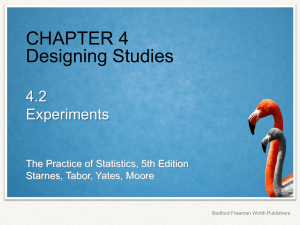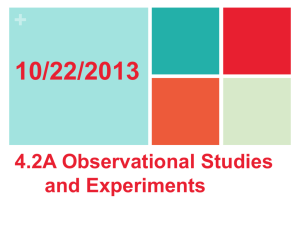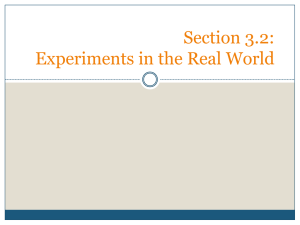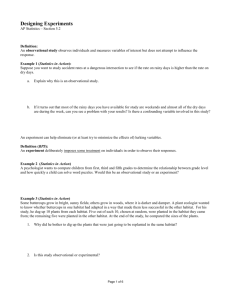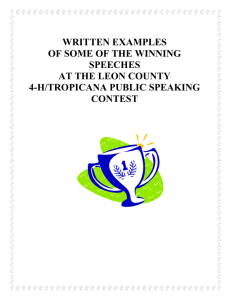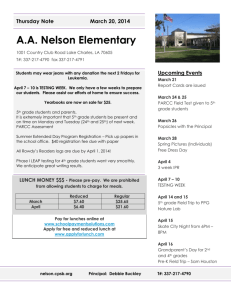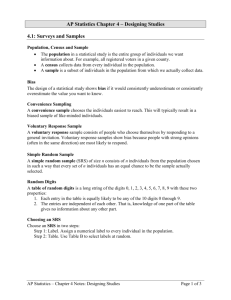experiment
advertisement
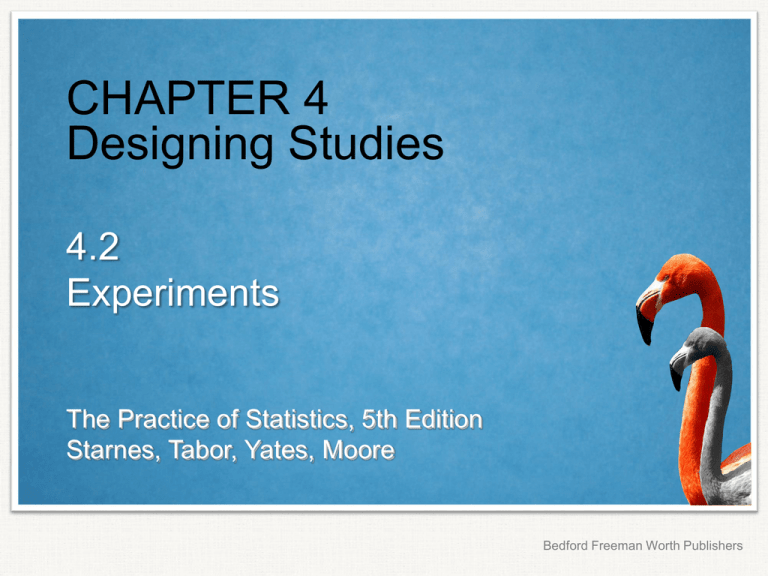
CHAPTER 4 Designing Studies 4.2 Experiments The Practice of Statistics, 5th Edition Starnes, Tabor, Yates, Moore Bedford Freeman Worth Publishers Experiments Learning Objectives After this section, you should be able to: DISTINGUISH between an observational study and an experiment. EXPLAIN the concept of confounding. IDENTIFY the experimental units, explanatory and response variables, and treatments in an experiment. EXPLAIN the purpose of comparison, random assignment, control, and replication in an experiment. DESCRIBE a completely randomized design for an experiment. DESCRIBE the placebo effect and the purpose of blinding in an experiment. INTERPRET the meaning of statistically significant in the context of an experiment. EXPLAIN the purpose of blocking in an experiment. DESCRIBE a randomized block design or a matched pairs design for an experiment. The Practice of Statistics, 5th Edition 2 Observational Study vs. Experiment An observational study observes individuals and measures variables of interest but does not attempt to influence the responses. An experiment deliberately imposes some treatment on individuals to measure their responses. When our goal is to understand cause and effect, experiments are the only source of fully convincing data. The distinction between observational study and experiment is one of the most important in statistics. The Practice of Statistics, 5th Edition 3 • See example on p.235 The Practice of Statistics, 5th Edition 4 Observational Study vs. Experiment Observational studies of the effect of an explanatory variable on a response variable often fail because of confounding between the explanatory variable and one or more other variables. Well-designed experiments take steps to prevent confounding. Confounding occurs when two variables are associated in such a way that their effects on a response variable cannot be distinguished from each other. To explain confounding you should explain how the variable you chose is associated with the explanatory variable and also how it affects the response variable. The Practice of Statistics, 5th Edition 5 • AP Exam Tip on p.236 – “Diet is a confounding variable because people with bad diets are more likely to have a heart attack” • Need to explain why diet is also associated with the choice to take hormones. • Would need to say something about why a better diet might be more common in the group of women who choose to take hormones. • AP common error on p.236 – For the hormone example you would need to explain not only that wealthier people tend to go to the doctor more often and to be healthier overall, but also that wealthier people are more likely to get hormone replacement. Thus, it could actually be the overall healthiness of wealthy women that caused the reduction in heart attacks, not any hormones they may have taken. • CYU on p.237 The Practice of Statistics, 5th Edition 6 The Language of Experiments An experiment is a statistical study in which we actually do something (a treatment) to people, animals, or objects (the experimental units) to observe the response. Here is the basic vocabulary of experiments. A specific condition applied to the individuals in an experiment is called a treatment. If an experiment has several explanatory variables, a treatment is a combination of specific values of these variables. The experimental units are the smallest collection of individuals to which treatments are applied. When the units are human beings, they often are called subjects. Often times the explanatory variables in an experiment are called factors. If an experiment has several factors, the combinations of each level of each factor form the treatments. The Practice of Statistics, 5th Edition 7 • See example on p.239 • http://www.ted.com/talks/michael_norton_how_to_buy_happiness#t107021 – Describes a multifactor experiment to determine if money can buy hapiness. – There are 2 factors, amount of money & how it is spent. The Practice of Statistics, 5th Edition 8 How to Experiment Badly Many laboratory experiments use a design like the one in the online SAT course example on p.240: Experimental Units Treatment Measure Response In the lab environment, simple designs often work well. Field experiments and experiments with animals or people deal with more variable conditions. Outside the lab, badly designed experiments often yield worthless results because of confounding. The Practice of Statistics, 5th Edition 9 How to Experiment Well The remedy for confounding is to perform a comparative experiment in which some units receive one treatment and similar units receive another. Most well designed experiments compare two or more treatments. Comparison alone isn’t enough, if the treatments are given to groups that differ greatly, bias will result. The solution to the problem of bias is random assignment. In an experiment, random assignment means that experimental units are assigned to treatments using a chance process. See example on p.241 The Practice of Statistics, 5th Edition 10 Principles of Experimental Design Principles of Experimental Design The basic principles for designing experiments are as follows: 1. Comparison. Use a design that compares two or more treatments. 2. Random assignment. Use chance to assign experimental units to treatments. Doing so helps create roughly equivalent groups of experimental units by balancing the effects of other variables among the treatment groups. 3. Control. Keep other variables that might affect the response the same for all groups. 4. Replication. Use enough experimental units in each group so that any differences in the effects of the treatments can be distinguished from chance differences between the groups. The Practice of Statistics, 5th Edition 11 • See example on p.243 The Practice of Statistics, 5th Edition 12 Completely Randomized Design In a completely randomized design, the treatments are assigned to all the experimental units completely by chance. Some experiments may include a control group that receives an inactive treatment or an existing baseline treatment. Group 1 Experimental Units Compare Results Random Assignment Group 2 The Practice of Statistics, 5th Edition Treatment 1 Treatment 2 13 • See example on p.245 • Read exam tip on p.246 • CYU on p.247 The Practice of Statistics, 5th Edition 14 Experiments: What Can Go Wrong? The logic of a randomized comparative experiment depends on our ability to treat all the subjects the same in every way except for the actual treatments being compared. Good experiments, therefore, require careful attention to details to ensure that all subjects really are treated identically. The response to a dummy treatment is called the placebo effect. In a double-blind experiment, neither the subjects nor those who interact with them and measure the response variable know which treatment a subject received. The Practice of Statistics, 5th Edition 15 • See example on p.247 • http://www.cbsnews.com/videos/treating-depression-is-there-aplacebo-effect/ The Practice of Statistics, 5th Edition 16 Inference for Experiments In an experiment, researchers usually hope to see a difference in the responses so large that it is unlikely to happen just because of chance variation. We can use the laws of probability, which describe chance behavior, to learn whether the treatment effects are larger than we would expect to see if only chance were operating. If they are, we call them statistically significant. An observed effect so large that it would rarely occur by chance is called statistically significant. A statistically significant association in data from a well-designed experiment does imply causation. The Practice of Statistics, 5th Edition 17 Blocking When a population consists of groups of individuals that are “similar within but different between,” a stratified random sample gives a better estimate than a simple random sample. This same logic applies in experiments. A block is a group of experimental units that are known before the experiment to be similar in some way that is expected to affect the response to the treatments. In a randomized block design, the random assignment of experimental units to treatments is carried out separately within each block. The Practice of Statistics, 5th Edition 18 Matched Pairs Design A common type of randomized block design for comparing two treatments is a matched pairs design. The idea is to create blocks by matching pairs of similar experimental units. A matched pairs design is a randomized blocked experiment in which each block consists of a matching pair of similar experimental units. Chance is used to determine which unit in each pair gets each treatment. Sometimes, a “pair” in a matched-pairs design consists of a single unit that receives both treatments. Since the order of the treatments can influence the response, chance is used to determine with treatment is applied first for each unit. The Practice of Statistics, 5th Edition 19 Experiments Section Summary In this section, we learned how to… DISTINGUISH between an observational study and an experiment. EXPLAIN the concept of confounding. IDENTIFY the experimental units, explanatory and response variables, and treatments in an experiment. EXPLAIN the purpose of comparison, random assignment, control, and replication in an experiment. DESCRIBE a completely randomized design for an experiment. DESCRIBE the placebo effect and the purpose of blinding in an experiment. INTERPRET the meaning of statistically significant in the context of an experiment. EXPLAIN the purpose of blocking in an experiment. DESCRIBE a randomized block design or a matched pairs design for an experiment. The Practice of Statistics, 5th Edition 20
